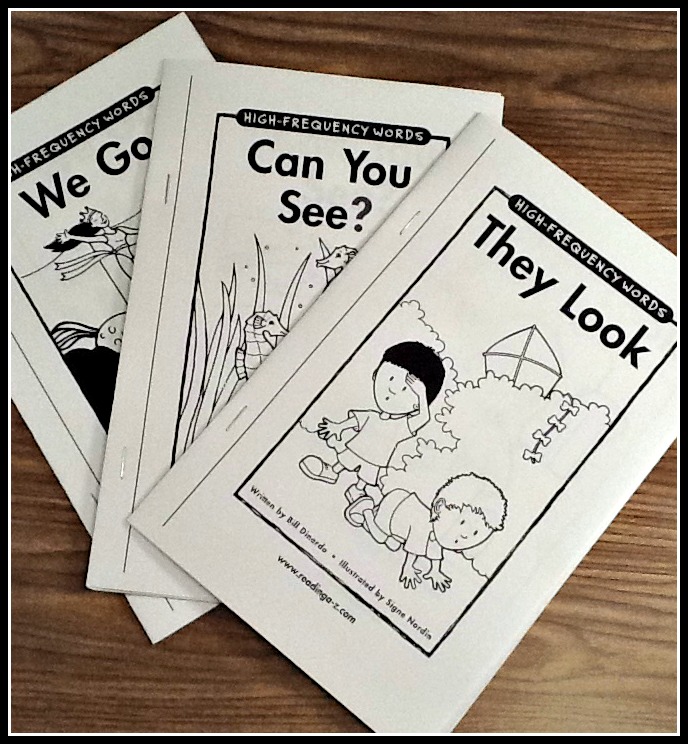Do you send home books for students to practice reading?
In the school district where I teach, many students don’t have access to books at their reading level. In the beginning, I also did not have access to books that I could send home for my kiddos.
So that my students could practice their sight words and CVC words in the context of reading books, I had to come up with an organized plan that worked for me and my students.
Perhaps you have a great system already or maybe you just need a new idea. Either way, this post might be helpful. And, if you have a way you think is more efficient and effective, I would love to hear from you!
Books!!!

Initially, I did not have books I could send home with the students to practice. Over time, a new adoption, and some internet research, I found some books that I could copy and send home with kids. But, I didn’t just want to copy books and send them home. So, I found ways to incorporate them into my classroom direct and indirect instructional time. That’s a post for another day along with websites to get lots of low cost or free books.
My students have to practice their books several times before ever getting to take them home. I want them to feel AND be successful when they go home to read by themselves. As you all know, not all parents participate in helping their children with homework either because they can not do it or they don’t want to do it. Therefore, I send home books that are at the student’s level of independence after the student has read the book fluently to me. That means each student reads their books as many times as it takes to be fluent before it goes home. Now for the tricky part! Organizing them.
How do you organize the books you send home with the students?
At the end of each school year, I start creating the folders you see above. To save myself time, I usually have intermediate students do this during their recess if they want to help out. I use thematic colors for each month. For example, I use red or green construction paper during the month of December simply because it helps me think of Christmas and I use blue for January (snow, arctic animals, cold weather), etc.
First, fold large construction papers in half, staple along the sides as shown in the picture above. I use 3 staples on each side. Now you have a pocket folder to stuff paper books in. If folding isn’t your thing and you don’t have volunteers to help you with this project, you may want to consider using manila folders or Ziploc gallon size bags.
Next, I copy a note to the parents along with the reading strategies I use in my classroom hoping parents will be able to help the kids and if not, the kids can help themselves with the reading strategy icons. GRAB IT FREE HERE! Either glue or staple it on. I prefer to staple although I have glued in the past. Once I have done this, I write numbers 1 through 10 on all the colors. I’ll explain this later.
Finally, these folders get stored in my filing cabinet alphabetically by student first names. Sometimes, I file them alphabetically by girls and then alphabetically by boys if I’m going to have the kids file their books so it’s easier.
Back to the Color System I Use
Above is the schedule I use. In August, I get 25 yellow sheets, fold them, and number them all “1” after stapling and adding the note. For September, I get 25 red sheets, fold them, and number them all “2” after stapling and adding the note. I continue this until all the months are complete.
All students will get a yellow #1 folder for the month of August. All books will go in this folder and when August is over, the folder gets sent home with all the books students are fluently reading. Continue doing this routine for every month.
As for the numbers, I explain to parents at Back to School night / conferences, students will end their Kindergarten year with 10 different colored folders with numbers 1 through 10. Each successive number the degree of difficulty gets a little bit harder. Therefore students can practice easier books or harder books as time goes on. I can also report to parents what folders students should read from if they are having difficulty or need more challenges thereby differentiating their homework and reading ability.
By the end of the year, each student should have approximately 200 books they have read all year and can continue to practice during the summer months. Parents have always come back to me and told me how well the folders and numbers on them worked out, how their child new just which books to read in which folders and how easy it was for them to organize and store especially during the summer vacation.

We enrolled our first daughter in this Phoenix preschool and will enroll our second daughter too this month. My first daughter loves the school and we expect our second to feel the same.
ReplyDelete